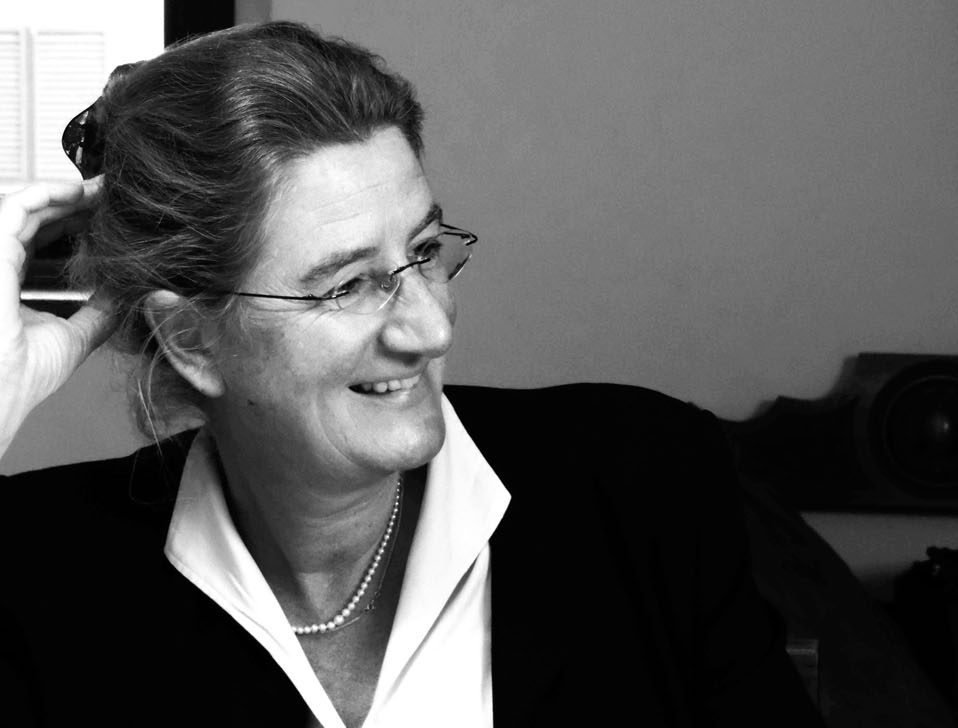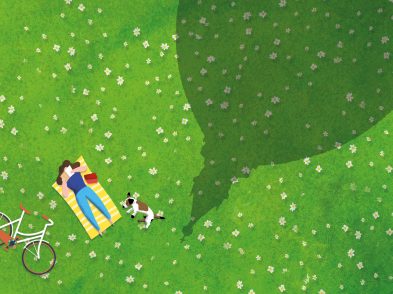On a high-season day more than 8,000 people visit the Accademia, making it the second most visited museum in Italy after the Uffizi.
Director of the Accademia Cecilie Hollberg spoke with The Florentine about the challenges and complexities of running the popular gallery.
Cecilie Hollberg | Ph. Leo Cardini
Helen Farrell: Earlier this year, an architect from Padua made the international headlines with an idea to move the David to an earthquake-proof museum. At what stage is the Accademia in the creation of seismic protection for the world’s most famous statue?
Cecilie Hollberg: First of all, this architect has been publishing things in newspapers and magazines since 2008; there are plenty of experts who openly give us advice without being familiar with our site, or without having the experience or capabilities needed to understand what can be done here. Building an underground bunker in a city like Florence means moving the David, which is enough to show us they really haven’t thought this through. There’s all this chatter in a local newspaper about moving it in the front of the new opera house. Everyone’s been asking about it. This statue is fragile, and that’s why it gets everyone so agitated. Yet, at the same time, everyone’s ready to move it all over the place—it’s a very strange situation. In any case, we’ve been working on this for years. The Ministry conducted many investigations on the building, the structure itself, and the possibilities that may arise, and since I’ve been here, we’ve been closely monitoring the statue. It’s cleaned every two months, financed by the Friends of Florence, and with every cleaning we are able to monitor the statue very closely. Every weak or fragile spot is regularly scrutinized time and time again so if there were any changes we would see them immediately. This aspect is something that’s always been under control. But, and I’m going to open a parenthesis here, there are some real absurdities out there. There was someone who sustained that the heat makes marble melt: it’s absurd. Marble changes its state of aggregation at 900 degrees centigrade.
HF: He’ll be fine then, even with our summers…
CH: There are all of these things that end up in the press because these poor souls want to link their name to Michelangelo’s David, hoping to end up in newspapers. Of course, they do end up in newspapers and we have to waste our time explaining to them that, in reality, marble does not melt. In addition, we created a framework agreement with DICEA, the University of Florence Department of Civil Engineering and Environment, in which we continue the already initiated investigation on the structure of the building. The structure is what’s important in the event of any sort of {seismic} movement. The base that holds the statue and blocks it from falling is entirely useless if the ceiling comes down on it. Thus, we made this framework agreement and the inspection will follow shortly, the only thing missing before we can decide what to do. I have been in contact with many institutions; I’ve been to the U.S. to the Getty Institute where there are several earthquake experts. Yet the reality remains that no one has ever worked with a statue like the David. All of these platforms are just fine for structures from 2 to 2.5 metres, but the David weighs 5,660 kilos and stands 5.17 meters tall. No one has ever experimented on a statue of this kind. They’ve experimented with the Riace Bronzes, but they’re much smaller and bronze is an entirely different material—it’s more flexible than marble. It’s an entirely different conversation, and so we can’t adapt the research done for that kind of model and apply it to an icon of the Renaissance. We really have to think about what we’re doing. The last thing I need is this group of charlatans coming to me with advice without knowing anything about the situation.
HF: Everyone comes to the Accademia for the David, but the gallery is home to countless important works of art. What is the Accademia doing to draw visitors to these other exhibits?
CH: We have plenty of strategies in place. I make the David get to work given he’s the star attraction, pulling in the visitors. Then once they’re here, we have them see the other collections. There are lots of people suggesting moving certain collections to other places in order to make more room in the museum. My response is always, “Absolutely not.” Florence is filled to the brim with beautiful museums that no one visits, so if we were to remove the Gipsoteca Bartolini {plaster cast gallery} and put it in another area, no one would visit it. It would end up like all of the other beautiful museums that no one goes to. Right now, we’re working on the signage to make it easier to find the other collections. For instance, visitors generally have trouble finding the first floor; they don’t see it because there are these little arrows all over the place that misguide people. It all has to be redone, including the musical instruments section. People don’t generally see it because it’s not easily recognizable and there aren’t signs that clearly lead to it. For us, this is a big step forward. To this end, we’ll be hosting a series of concerts to spotlight the collection of musical instruments. The first was on October 23, financed by the Associazione degli Amici della Galleria dell’Accademia. The second will be in December, the second of four concerts.
We also take advantage of unexpected geniuses, like the rock revolutionary of the 20th century, Mick Jagger, who recently came by.
Leo Cardini: Who’s more famous, Mick Jagger or the David?
CH: Well, for a second I thought let’s move the David and put Mick Jagger in there…{laughs} After Mick Jagger posted on Instagram I got a phone call from the Ministry’s spokesman who said that Rai wanted to come do an interview about Mick Jagger’s visit. I had to tell them, “I’m sorry, Mick Jagger isn’t here anymore,” to which they replied, “No, it doesn’t matter!” And so they ended up coming. I took them to the musical instruments section, so during the interview that ended up on TV, we’re not standing in front of the David. All of Italy was watching, which means that now everyone knows about the museum of musical instruments.
We’re also involved in conferences. For example, this year at The British Institute of Florence I gave a talk on the Gipsoteca and plaster casts of Englishmen—the busts and plaster casts by Lorenzo Bartolini—and it was received with great enthusiasm. Also, at the recent Biennale, not only did we purchase the “fondi oro” {medieval gold-background panel paintings}, which are just spectacular, truly exceptional because we are able to also reconstruct a part of an altar, but the Associazione degli Amici della Galleria dell’Accademia donated a marble bust by Lorenzo Bartolini to us. This is the first and only marble bust that the Accademia will conserve in its own collection. This bust is really beautiful: it’s of Niccolini, the one here in the old via del Cocomero where Teatro Niccolini is.
We also put on exhibitions. Last year we did one on Giovanni dal Ponte that was quite exquisite. This year we are planning an exhibition on 14th-century textiles in Florence: wool, silk and painting. It’ll open in December and its aim is to illustrate the relationship between textiles and painting, not in the sense of finding the exact piece of fabric that was used in a painting, but to explain the development of patterns and textiles, and the patterns that were then inherited in paintings later on. These fabrics were obviously very expensive, so a painter couldn’t afford to buy a piece of silk to paint it. He had to go see it somewhere, or he needed the chance to go into a workshop and see the drawings. And then every workshop would pick their type of fabric model and would depict it repeatedly. The representation of fabric is interesting because an exhibit of this kind has never been done before, especially with this comparison of the evolution of fabrics that begins with simple patterns and then develops, especially with the influence of the East and the Mediterranean.
HF: Is the Textile Museum of Prato also involved in this?
CH: Yes, we collaborated with them because of their vast experience in this sector. I like leaning on people who are experts in a field, who are interested, and they truly do a wonderful job in Prato.
I hope that this exhibit will also be an opportunity for them to attract more visitors. On the back of the tickets we’ll print advertisements for their museum, so it’s been a collaborative process.
We also have an international scientific committee, which includes the director of the Abegg Foundation in Switzerland, an institution at the apex for international textile restoration.
HF: This summer brought its difficulties for the museum due to the heat and queues. How will the Accademia approach next year’s high season? Can visitors expect additional capping on entry or increased ticket prices?
CH: The ticket prices, for now, will not increase. The queues outside the museum will exist as long as the museum’s space remains as it is. I have created a technical panel with the Accademia di Belle Arti and we’re having the two ministries collaborate—they are Miur, Ministry of Education, Universities and Research, and we are Mibac, Ministry of Cultural Heritage and Activities—so we’ve combined the two ministries to find solutions. They seem to be open to very close collaboration, including leaving us spaces in the area. I hope that this will be accomplished so that it can lighten the crowd situation.
The queues tend to flow fairly quickly. In a year like this one, the temperature, which reached 43 degrees for two weeks, was completely unexpected. It was exactly when that we had begun working on the air conditioning system, which in certain parts is 40 years old, and in some rooms doesn’t even exist. Since I’ve been here I’ve been looking for a solution, but virtually nothing can be done without an internal architect—if you don’t have someone on the inside of a state institution, everything stands still. So for now, I’ve become an expert on plant engineering, sewers and such things. {laughs}
Everyone standing outside is a walking heater. If in the high summer season, 8,000 heaters walk into the building, everything collapses. We spoke with the local health authority, and everything is up to code. The only weak point is the Gipsoteca, which doesn’t have air conditioning. As a precaution, if we see that the temperature is becoming unbearable, we close the section so people can still take a peek through the gate, but they can’t go in. All of this to say that I’ve been planning an air conditioning system for the gipsoteca, a way of letting air pass through—all of the things that are necessary but that weren’t considered 40 years ago. In addition, and I don’t want to speak too much about the engineering because it’s very boring and I can’t possibly explain all of it, but our systems continued to work while another large museum in the city had to close down. Fortunately, this didn’t happen to us. We had those very old motors fixed and things are running just fine.
We also decided to hand out fans to the public waiting in front of the main entrance. We put a picture of the David on there, so no one will throw it away, and then we had the name of the museum written on the David because I’ve realized that no one knows that the Galleria dell’Accademia di Firenze corresponds to this museum. When someone says, “the David,” things suddenly click, so I put it everywhere. Also, this year we launched our website, so people can use the QR code while they are in line to maybe orient themselves, check out the museum map, find out where the bathrooms are, and so on. We have also listed the official prices on there. There’s a lot of people standing in front of the museum selling tickets that are usually free for people under 18, for 30, 40, even 50 euro. To me, this is completely unacceptable, so the fans became a way to educate and inform the people waiting outside the museum.
HF: How is the Accademia reacting to the threat of terrorism?
CH: After the attack in Barcelona, both the Ministry and I asked for increased security. Visible and non-visible measures were employed, and we upped security at the entrance. We’ve always had metal detectors, but now we prohibit water bottles. All of this information can be found on our website.
HF: The Uffizi launched Instagram and Twitter channels a little over a year ago, which have proven a massive success. When will the Accademia be joining the realm of social media?
CH: Yes, that is our intention. We were the first among the state museums to have a website, which, without an administrator or an I.T. person, was quite a feat. We’d like to form a social media presence. A museum like this one, which hosts around five million visitors a year, with this wonderful David character, is a museum that needs to control the texts and images that we publish. We can’t abandon the task to just anyone, so right now, being 40 per cent understaffed, we’re focusing on the essential things. The new website is already a huge relief because we’ve been able to cut out time-consuming phone calls, like about opening and closing times.
In any case, we’re working on entering the social media world. As I said, someone like Mick Jagger who posted the photo, “Me and David in Florence,” is the type of thing that works for us, just like when Steven Tyler came by and posted on social media.
HF: What about catering to families?
CH: We’ve started honing in on working with young people, especially since, strangely, many state museums don’t consider the presence of children, something that to me is incomprehensible. This year, we changed the text of our audio guides and added the first audio guide for children. The “Davidino” takes children around with the restorer, Matteo, who explains things to the children. It’s available in five different languages (Italian, Spanish, French, English and German). We’re also working on a small book for children, the first one to focus on the Galleria dell’Accademia.
We also started working with interns from the University of Florence, until now in art history. Yesterday a student from Milan started working here and she’ll be working on questionnaires for visitors to help us understand the before and after effects of the signage in the museum—what to change, what’s missing. The museum map available on the website is by an American student studying at SACI, who spent a semester with us. We exchanged some ideas about what we could work on, and then at the presentation, I saw her map and said to myself, the maps that we have are completely impractical. That’s how we ended up using hers.
A couple of weeks ago we did a lovely project: after waiting since January, we finally hit the jackpot with this art historian really interested in education. She did a project with some university interns: the interns taught student art ambassadors, who in turn, explained certain artworks to visitors, besides also speaking to eighth-grade students. The school involved is the Buontalenti hospitality school, and so the students didn’t really have any contact with art. We also did an interview that’s on YouTube—see, we are on social media! With projects like these we can move young people closer to art.









